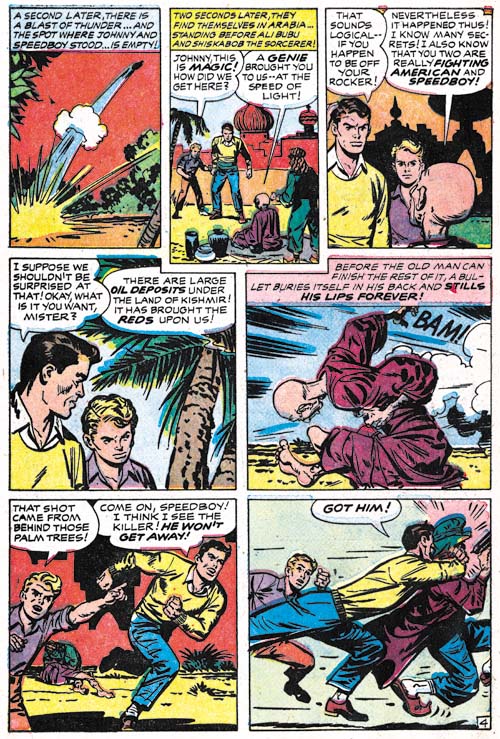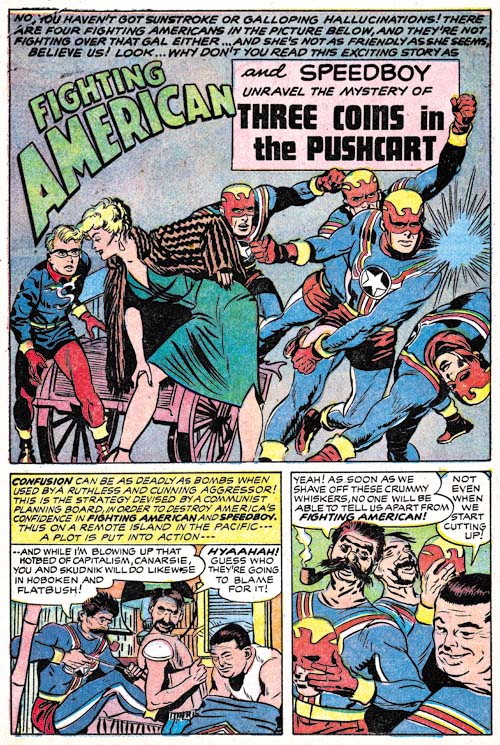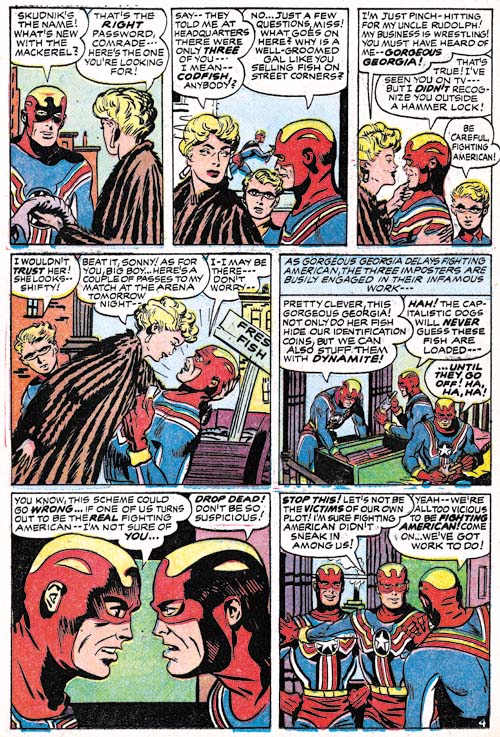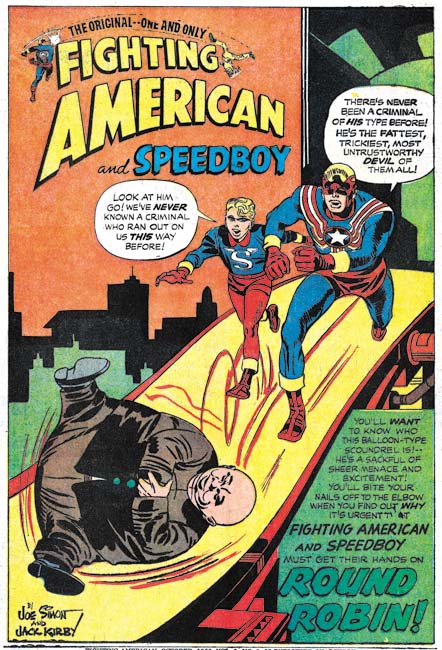
Fighting American #7 (April 1955) “Sneak Of Araby”, art by Jack Kirby
The lead story for issue #7 has Fighting American fighting the commies in Arabia over oil (of course). A clever splash but one with a frequently used theme of villains trying to avoid detection but clueless as to their impending encounter with Fighting American and Speedboy.

Fighting American #7 (April 1955) “Sneak Of Araby” page 4, art by unidentified artist
The Jack Kirby Checklists assigns 4 pages of this 8 page story to Kirby but other then the splash page none of it looks like his work to me and I do not think they are his layouts either. Panel 5 of page 4 looks to me like Kirby’s pencils and inking but that panel is the only convincing work by Kirby in the story. I suspect this particular case was Kirby acting as art editor and fixing up a poorly done panel. So far I have not been able to identify the artist.

Fighting American #7 (April 1955) “Three Coins In The Pushcart”, art by John Prentice
For “Three Coins In The Pushcart” the Jack Kirby Checklist only credits the splash to Jack. Frankly I do not see Kirby in any part of the story including the splash and again not even the layouts.

Fighting American #7 (April 1955) “Three Coins In The Pushcart” page 4, art by John Prentice
There a clues on the splash page that John Prentice is the correct artist to attribute this story to but it can best be seen with page 4. As far as I know Prentice did no other superhero work so there is nothing to compare this story to. However John’s women are usually quite distinctive and the lady in the second panel was clearly done by him. Comparison of this work to four pages of “Super Khakalovitch” from Issue #6 convinces me that John Prentice was also the artist for part of that work as well. This may not have been his finest work but he handles both the action and humor surprisingly well considering both are elements not normally associated with Prentice.

Fighting American #7 (April 1955) “Space-Face”, pencils by Jack Kirby and inks by Mort Meskin
What a delightful set of characters in the splash panel for “Space-Face” each with their own distinctive features and emotions. The inking for this splash is has a characteristic simplicity particularly in the eyebrows that identifies Mort Meskin as the inker. One striking feature of the splash is the way the bottom edge cuts off the lower part of two faces. While I am not going to say Kirby never does this, it certainly is not typical for Jack but it was a frequently used device by Meskin particularly in the Vigilante work Mort did for DC during the war (link). Because of this I briefly entertained the notion that the splash was actually drawn by Mort but the faces are so typical of Kirby that I just as quickly rejected the idea. In particular note the one guy to our left of Speedboy; take away the cigarette and he looks just like Scrapper from the Newsboy Legion.

Fighting American #7 (April 1955) “Space-Face” page 4, pencils by Jack Kirby and inks by Mort Meskin
Because of the splash panel I paid close attention to the story pages to check if they were done by Kirby or Meskin. Well the layouts generally look like Jack’s and page 4 is especially convincing. The way the figures run in the top panels is typical for Kirby. Note how the sole of the foot of the running boy in panel 3 turns to the viewer. This device was frequently used by Kirby (also by Joe Simon) but I have never seen Mort do it. So while I believe Mort Meskin did the inks, I am convinced Jack Kirby did the actual pencils. Fighting American #7 was the last issue published by Prize Comics. Occasionally you will come across a claim that Fighting American was cancelled because of the Comic Code. However the evidence does not support that view. It is true that the earlier issues had art that would have been unacceptable under the Comic Code, but issue #7 was published with the Comic Code stamp without any apparent problems. Further the art work had been completed for issue #8 and would be published years later again without any difficulties with the Comic Code. Because Fighting American is today viewed by many as one of Simon and Kirby’s greatest creations it would have been nice to blame its failure on the Comic Code but the correct explanation is simply that it did not sell well enough. That it was a tough time for comics in general and superheroes in particular probably did not help.

Fighting American #1 (October 1966) “Round Robin”, art by Jack Kirby
In 1966 Harvey published a Fighting American comic that was a combination of reprint material and previously unpublished stories. The cover and the “new” art were all done by Jack Kirby and were inked in a manner typical of the original Simon and Kirby productions. Fighting American #7 had 20 pages of Fighting American stories and that is exactly the same number of pages for the new stories found in the Harvey’s Fighting American #1. There is little doubt that this material was originally meant for issue #8 of Prize’s Fighting American but went unused when that comic was cancelled. The biggest difference between FA #7 and what would have been FA #8 was that Kirby contributed all the art for the cancelled Fighting American stories while he did not do all the art for FA #7.
The lead story for the Harvey FA comic was “Round Robin”. The shortness of this story (only 5 pages) is not obvious because it is broken up by the inclusion of a reprint of the Fighting American origin story. The splash seems to have been modified specifically for the Harvey comic. I believe the “the original one and only” text in the title as well as the small Fighting American and flying figures were late additions. Also the Simon and Kirby signature is in Joe Simon’s handwriting and does not match the original style and was added later.
There was a lot of variation in the costumes in the original Fighting American series. The most glaring was perhaps the way Speedboy would usually have blue trunks and red leggings but sometimes red trunks and blue leggings. But for the Harvey comic invariably both the trunks and leggings of Speedboy are red, a combination not seen previously.

Fighting American #1 (October 1966) “Roman Scoundrels”, art by Jack Kirby
The splash for “Roman Scoundrels” has the car touche that reads “produced by Simon and Kirby”. Comics put together by the Simon and Kirby studio almost always had this car touche on the lead story. Thus this is another indication that the new art in the Harvey comic was original intended as issue #8 of the Prize title and that “Roman Scoundrels” was meant to have been the lead story for that cancelled issue.
In “Roman Scoundrels” the heroes take part in the filming of a Hollywood movie where the villain replaces harmless stunts with ones meant for lethal consequences. I am sure that Simon and Kirby had used this plot before, but at this moment I do not remember where.

Fighting American #1 (October 1966) “Yafata’s Moustache”, art by Jack Kirby
I may feel that Simon and Kirby jumped the shark in “Super Khakalovitch” from FA #6, however all the stories for the defunct issue #8 are actually quite good. My favor ate is “Yafata’s Moustache” a story that perfectly balances the action and humor the two elements that made Fighting American such a unique superhero.
Superheroes were once again a big thing in 1966 and at least a second issue of Fighting American was initially planned by Harvey. It was to be a combination of reprint and new material like the previous issue. However there was no more unpublished Fighting American art left over from the Prize series so Joe Simon created a new cover and had George Tuska create the art for two new stories (“The Beef Box” and “The Mad Inker”). Unfortunately Harvey’s Fighting American #2 was cancelled. “The Beef Box” would eventually be included in the Fighting American reprint book published by Marvel in 1986. “The Mad Inker” has never been published probably because the splash page was already missing from Joe Simon’s collection by 1986.


A fascinating piece. I’d often wondered where that George Tuska story in the Marvel volume came from. Thanks for clearing that up. As for the unknown artist in FA # 7, I’m hardly the expert you are but my first thought was that it looked like Simon’s work.